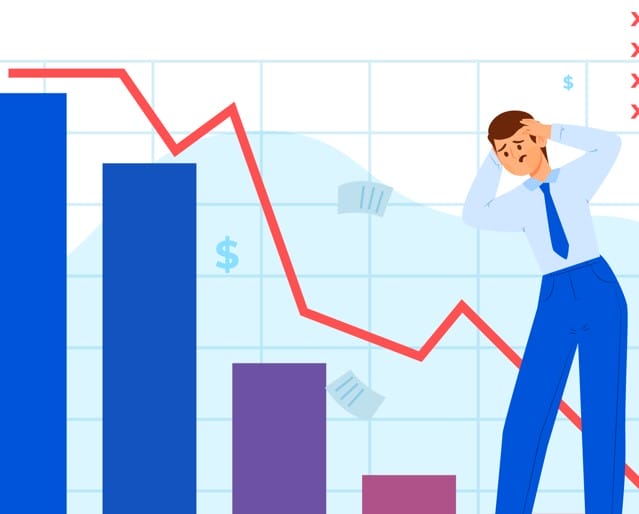Forex trading, also known as foreign exchange trading or currency trading, is a dynamic and highly volatile financial market where traders buy and sell currencies with the aim of making a profit. While the potential for substantial returns exists, the nature of the forex market can also lead to sleepless nights for traders. In this essay, we will explore the various factors that contribute to the sleeplessness associated with forex trading, examining both the excitement and challenges that traders face in this fast-paced environment.
High Market Volatility
Volatility refers to the degree of variation in the price of a financial asset over time. In the context of forex trading, high market volatility implies that currency prices can fluctuate significantly within short periods. There are several reasons why the forex market experiences high levels of volatility:

- Market Participants: The forex market is decentralized and consists of a diverse array of participants, including central banks, commercial banks, hedge funds, institutional investors, and individual traders. Each participant has different motives and strategies, leading to varied trading patterns that contribute to market volatility.
- Economic Indicators and News Releases: Economic indicators, such as inflation rates, employment figures, GDP growth, and interest rate decisions, have a profound impact on currency prices. When important economic data is released, it can cause sharp movements in the forex market as traders react to new information and adjust their positions accordingly.
- Geopolitical Events: Geopolitical events, such as elections, geopolitical tensions, trade disputes, and geopolitical crises, can also influence currency prices. Uncertainty surrounding geopolitical developments can lead to heightened volatility as traders reassess their risk exposure and investment strategies.
- Market Sentiment: Market sentiment, or the overall attitude of traders and investors toward a particular currency or market, plays a significant role in driving volatility. Positive sentiment can lead to bullish trends, while negative sentiment can result in bearish trends, causing prices to fluctuate rapidly.
- Liquidity: The forex market is highly liquid, meaning that currencies can be bought and sold quickly without significantly impacting prices. While liquidity is generally advantageous for traders, it can also contribute to volatility, especially during periods of heightened trading activity when large orders are executed.
The high volatility of the forex market presents both opportunities and challenges for traders. On one hand, volatile markets offer the potential for substantial profits through well-timed trades. On the other hand, they also pose a greater risk of significant losses if trades are not properly managed. Traders must be prepared to navigate the ups and downs of volatile market conditions, which can lead to sleepless nights as they monitor price movements and adjust their trading strategies accordingly.
24-Hour Market Operation
The forex market operates continuously, 24 hours a day, five days a week, making it unique among financial markets. This non-stop operation is due to the global nature of currency trading and the involvement of major financial centers across different time zones. The continuous operation of the forex market has several implications for traders:
- Global Market Sessions:
- Asian Session: The trading day begins in the Asia-Pacific region, with major financial centers like Tokyo and Hong Kong active. Currency pairs involving the Japanese Yen are often actively traded during this session.
- European Session: As the Asian markets wind down, the European session starts with financial hubs like London opening. The majority of forex trading volume occurs during the overlap of the European and Asian sessions, making this a particularly active time for the market.
- North American Session: The market remains active as the European session overlaps with the North American session, where major financial centers like New York are prominent. The U.S. dollar is involved in a significant portion of forex transactions during this session.
- Continuous Trading Opportunities:
- The 24-hour market operation provides traders with continuous opportunities to enter or exit positions. This flexibility allows individuals from various time zones to participate in the market at times that suit their schedules.
- Traders can react to news and events that occur outside regular business hours, which can lead to price gaps or significant movements when the market reopens.
- Challenges of Non-Stop Trading:
- The constant availability of the market can lead to disrupted sleep patterns as traders feel the need to stay alert during different market sessions.
- Traders may find it challenging to maintain a healthy work-life balance, as the market’s continuous operation can blur the boundaries between professional and personal life.
- Overnight Risk:
- Positions held overnight are exposed to potential market gaps or price fluctuations when major financial centers are closed. Economic events or news releases during off-hours can result in significant changes in currency prices.
- Global Economic Events:
- Economic events and data releases from different parts of the world can impact currency values during specific market sessions. Traders need to be aware of the economic calendar to anticipate potential market-moving events.
While the 24-hour nature of the forex market provides traders with ample opportunities, it also introduces challenges related to sleep patterns, work-life balance, and the need for constant vigilance. Traders may find themselves monitoring the market during unconventional hours, leading to sleepless nights, especially when events unfold during periods of low liquidity or when they hold positions overnight. The continuous operation of the market demands adaptability and effective time management from traders participating in this dynamic financial environment.
Global Economic Events and News Releases
The forex market is heavily influenced by economic events and news releases that provide crucial information about the economic health and conditions of countries involved in currency trading. Traders closely monitor these events as they can have a significant impact on currency prices. Here’s a detailed explanation of the factors under this heading:
- Economic Indicators:
- Interest Rates: Central banks set interest rates, and changes in these rates influence currency values. Higher interest rates attract foreign capital, strengthening the currency, while lower rates may have the opposite effect.
- Gross Domestic Product (GDP): GDP measures the economic output of a country. A growing economy is generally associated with a stronger currency, while economic contraction may weaken the currency.
- Employment Data: Reports on employment, such as non-farm payrolls, can affect currency prices. High employment figures are viewed positively and may strengthen a currency.
- Inflation Rates: Central banks aim to maintain stable inflation. Higher inflation may lead to currency depreciation, while low inflation can support a stronger currency.
- Central Bank Decisions:
- Central banks play a crucial role in the forex market. Decisions on interest rates, monetary policy, and quantitative easing can have immediate and profound effects on currency values.
- Traders closely follow central bank statements and press conferences for hints about future policy decisions, as these can impact market sentiment.
- Economic Calendar:
- Traders use economic calendars to stay informed about upcoming economic events and releases. These calendars highlight dates and times for key announcements, including central bank meetings, employment reports, and inflation data.
- Events marked on the economic calendar are potential catalysts for market movements, and traders often plan their strategies around these dates.
- Market Reaction to News Releases:
- News releases can lead to rapid and unpredictable market movements. Traders may witness significant price spikes or declines in the aftermath of economic data releases.
- Volatility around news events can result in both opportunities and risks for traders, requiring quick decision-making and risk management.
- Trading the News:
- Some traders specialize in news trading, aiming to capitalize on short-term price movements triggered by economic events. This strategy requires a deep understanding of market reactions and quick execution.
- However, trading the news also comes with risks, including slippage and heightened volatility that can lead to unexpected losses.
- Anticipation and Anxiety:
- Traders often experience a sense of anticipation and anxiety leading up to significant economic events. The uncertainty surrounding the outcome of these events can contribute to sleepless nights as traders weigh potential market reactions.
- The need to stay vigilant and be prepared for unexpected developments during news releases adds to the psychological stress associated with forex trading.
Understanding the impact of global economic events and news releases is essential for forex traders. Successful navigation of these events requires a combination of market analysis, risk management, and the ability to react swiftly to changing market conditions. The anticipation and anxiety associated with key economic announcements contribute to the sleeplessness often experienced by traders, especially when holding positions during volatile periods.
Risk Management Challenges
Effective risk management is a cornerstone of successful forex trading, as it involves strategies and practices aimed at preserving capital and minimizing potential losses. The challenges associated with risk management in forex trading are multifaceted and require careful consideration:
- Position Sizing:
- Determining the appropriate size of a trading position is a critical aspect of risk management. Traders need to strike a balance between maximizing potential profits and limiting potential losses.
- Overly large positions relative to account size can lead to significant losses if the market moves unfavorably. Conversely, overly conservative position sizing may limit profit potential.
- Leverage:
- Leverage amplifies both potential gains and losses in forex trading. While it allows traders to control larger positions with a smaller amount of capital, it also increases the risk of substantial losses.
- Managing leverage effectively involves understanding its impact on trading positions and setting leverage levels that align with one’s risk tolerance.
- Stop-Loss Orders:
- Stop-loss orders are used to automatically close a position at a predetermined price to limit potential losses. Setting appropriate stop-loss levels is crucial for protecting capital.
- Traders face the challenge of placing stop-loss orders at levels that provide sufficient protection while avoiding setting them too close to the current market price, which can lead to premature exits.
- Market Volatility:
- High market volatility introduces challenges to risk management. Rapid and unpredictable price movements can trigger stop-loss orders or result in slippage, where trades are executed at a different price than expected.
- Traders must adapt their risk management strategies to account for the dynamic nature of market volatility.
- Correlation Risks:
- Correlation refers to the degree to which currency pairs move in relation to each other. Understanding and managing correlation risks is essential, as trading highly correlated pairs simultaneously can increase overall risk.
- Diversification and awareness of correlated market movements are key elements in mitigating correlation risks.
- Emotional Challenges:
- Emotional factors, such as fear and greed, can pose challenges to effective risk management. Fear of losing money may lead to hesitation in executing trades or reluctance to cut losses, while greed may drive excessive risk-taking.
- Developing discipline and emotional resilience is crucial for maintaining a consistent and effective approach to risk management.
- Risk-Reward Ratio:
- The risk-reward ratio is the relationship between the potential profit and potential loss in a trade. Traders aim to maintain a favorable risk-reward ratio to ensure that potential profits outweigh potential losses.
- Balancing the risk-reward ratio requires careful analysis and decision-making, considering both market conditions and individual trading strategies.
- Adaptability to Market Conditions:
- Markets are dynamic, and conditions can change rapidly. Traders must be adaptable and adjust their risk management strategies based on evolving market conditions, news events, and economic data releases.
- Failure to adapt to changing circumstances can expose traders to unexpected risks and increase the likelihood of sleepless nights.
The challenges associated with risk management underscore the importance of developing a comprehensive and flexible risk management plan. Traders need to continually assess and refine their risk management strategies to align with their evolving trading styles, market conditions, and risk tolerance. The complexities involved in striking the right balance between risk and reward contribute to the stress and anxiety that traders may experience, especially during turbulent market periods.
While the allure of financial success drives many individuals to participate in the forex market, it is essential for traders to be aware of the potential psychological and emotional toll. Developing effective risk management strategies, maintaining a healthy work-life balance, and seeking support when needed can contribute to a more sustainable and less stressful trading experience. Ultimately, understanding the multifaceted nature of forex trading can help traders navigate the challenges and strive for success while promoting overall well-being.







